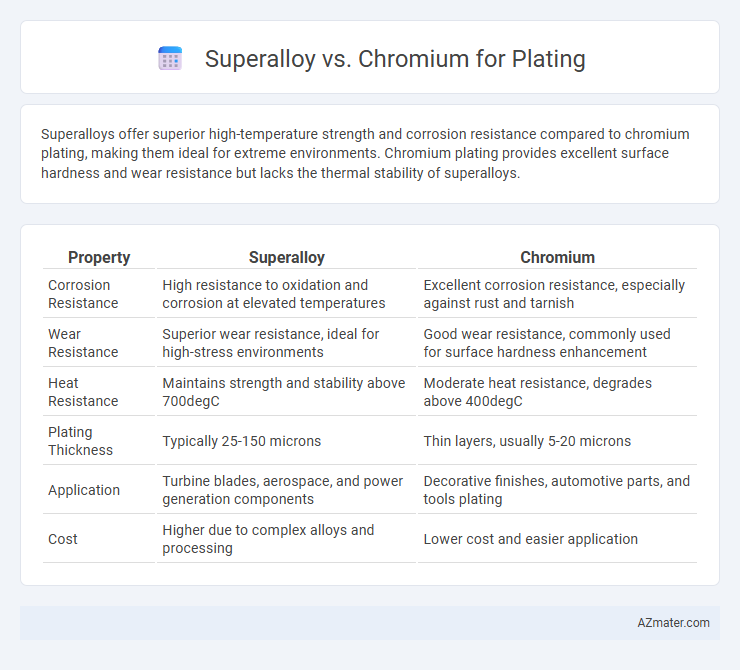Superalloys offer superior high-temperature strength and corrosion resistance compared to chromium plating, making them ideal for extreme environments. Chromium plating provides excellent surface hardness and wear resistance but lacks the thermal stability of superalloys.
Table of Comparison
| Property | Superalloy | Chromium |
|---|---|---|
| Corrosion Resistance | High resistance to oxidation and corrosion at elevated temperatures | Excellent corrosion resistance, especially against rust and tarnish |
| Wear Resistance | Superior wear resistance, ideal for high-stress environments | Good wear resistance, commonly used for surface hardness enhancement |
| Heat Resistance | Maintains strength and stability above 700degC | Moderate heat resistance, degrades above 400degC |
| Plating Thickness | Typically 25-150 microns | Thin layers, usually 5-20 microns |
| Application | Turbine blades, aerospace, and power generation components | Decorative finishes, automotive parts, and tools plating |
| Cost | Higher due to complex alloys and processing | Lower cost and easier application |
Introduction to Plating: Superalloy vs Chromium
Superalloy and chromium plating are distinct methods used to enhance surface properties like corrosion resistance, wear resistance, and thermal stability. Superalloy plating typically involves nickel-based alloys with high strength and oxidation resistance, ideal for extreme environments. Chromium plating offers a hard, corrosion-resistant surface with excellent hardness and low friction, commonly applied in automotive and industrial components.
Chemical Composition and Structure Comparison
Superalloys typically consist of nickel, cobalt, or iron bases combined with elements like chromium, aluminum, and titanium, forming a complex, multi-phase microstructure that provides exceptional high-temperature strength and corrosion resistance. Chromium plating, primarily composed of elemental chromium, offers a hard, dense, and crystalline layer that excels in wear resistance and surface hardness but lacks the internal microstructural complexity of superalloys. The chemical composition of superalloys enables tailored mechanical properties through alloying and heat treatment, while chromium plating provides a thin, uniform coating focused on surface protection rather than bulk structural enhancement.
Mechanical Properties and Durability
Superalloy coatings exhibit superior mechanical properties, including enhanced tensile strength and high-temperature resistance, compared to chromium plating. Chromium plating provides excellent hardness and corrosion resistance but is more prone to brittleness and wear under extreme mechanical stress. The durability of superalloy plating outperforms chromium in applications demanding long-term thermal stability and mechanical resilience.
Corrosion and Oxidation Resistance
Superalloys exhibit superior corrosion and oxidation resistance compared to chromium plating, especially at high temperatures and in aggressive environments. Chromium plating provides a hard, wear-resistant surface with moderate corrosion protection but tends to degrade under prolonged exposure to corrosive agents and elevated heat. For applications requiring long-term durability in extreme conditions, superalloys offer enhanced stability due to their complex composition and oxide layer formation.
Wear and Abrasion Performance
Superalloy coatings exhibit superior wear and abrasion resistance compared to traditional chromium plating, thanks to their enhanced microstructural stability and higher hardness levels. Chromium plating tends to suffer from brittleness and micro-cracking under extreme abrasion, reducing its effectiveness in high-friction applications. The advanced composition of superalloys, often containing elements like nickel, cobalt, and aluminum, provides a more durable barrier against surface degradation and prolongs component lifespan in demanding environments.
Application Industries and Use Cases
Superalloy coatings excel in aerospace and power generation industries, providing superior oxidation and corrosion resistance at high temperatures for turbine blades, jet engines, and gas turbines. Chromium plating is widely used in automotive, tooling, and manufacturing sectors, offering enhanced surface hardness, wear resistance, and corrosion protection for components like engine parts, molds, and hydraulic cylinders. Both materials serve critical roles in extending equipment life and performance under demanding operational conditions.
Environmental Impact and Safety Concerns
Superalloy plating typically involves nickel-based alloys known for corrosion resistance and high-temperature stability, but their manufacturing process can release hazardous emissions and heavy metals, raising environmental and worker safety concerns. Chromium plating, especially hexavalent chromium, poses significant toxicity risks, including carcinogenicity and environmental persistence, necessitating stringent handling protocols and pollution control measures. Advances in trivalent chromium plating and greener superalloy alternatives aim to reduce ecological footprint and improve occupational health outcomes.
Cost Analysis: Superalloy vs Chromium Plating
Superalloy plating generally incurs higher costs due to the use of expensive base materials like nickel and cobalt alloys combined with advanced deposition techniques. Chromium plating remains more cost-effective with widespread availability and simpler electroplating processes, reducing labor and operational expenses. For applications prioritizing durability and corrosion resistance, the increased investment in superalloy plating may justify lifecycle cost savings despite its higher initial expenditure.
Advancements and Innovations in Plating Technologies
Advancements in plating technologies have significantly enhanced the performance of superalloys by improving their resistance to oxidation, corrosion, and high-temperature wear compared to traditional chromium plating. Innovations such as pulse electroplating and physical vapor deposition (PVD) techniques allow for more uniform, adherent, and environmentally friendly coatings on superalloys, surpassing the hardness and durability typically achieved with chromium. These cutting-edge methods enable tailored surface properties, extending the lifespan of components in aerospace and industrial applications where superalloys are preferred for their superior mechanical strength and thermal stability.
Conclusion: Choosing the Right Plating Solution
Superalloy plating excels in high-temperature resistance and mechanical strength, making it ideal for aerospace and turbine applications, while chromium plating offers superior corrosion resistance and a bright, wear-resistant finish for automotive and decorative uses. Selecting the right plating solution depends on specific performance requirements, such as thermal stability, abrasion resistance, and environmental exposure. Evaluating factors like operating conditions, longevity, and cost-effectiveness ensures optimal material protection and component performance.

Infographic: Superalloy vs Chromium for Plating
 azmater.com
azmater.com